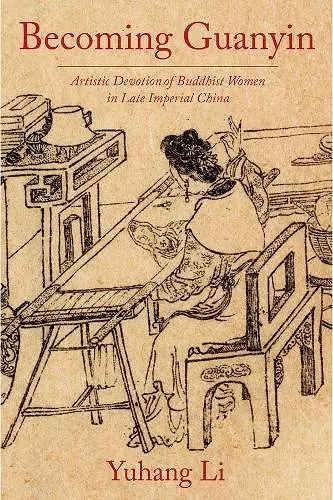Becoming Guanyin
Artistic Devotion of Buddhist Women in Late Imperial China
Format:Hardback
Publisher:Columbia University Press
Published:27th Mar '20
Currently unavailable, and unfortunately no date known when it will be back

Winner, 2024 Geiss-Hsu Book Prize for Best First Book, Society for Ming Studies
The goddess Guanyin began in India as the bodhisattva Avalokiteśvara, originally a male deity. He gradually became indigenized as a female deity in China over the span of nearly a millennium. By the Ming (1358–1644) and Qing (1644–1911) periods, Guanyin had become the most popular female deity in China. In Becoming Guanyin, Yuhang Li examines how lay Buddhist women in late imperial China forged a connection with the subject of their devotion, arguing that women used their own bodies to echo that of Guanyin.
Li focuses on the power of material things to enable women to access religious experience and transcendence. In particular, she examines how secular Buddhist women expressed mimetic devotion and pursued religious salvation through creative depictions of Guanyin in different media such as painting and embroidery and through bodily portrayals of the deity using jewelry and dance. These material displays expressed a worldview that differed from yet fit within the Confucian patriarchal system. Attending to the fabrication and use of “women’s things” by secular women, Li offers new insight into the relationships between worshipped and worshipper in Buddhist practice. Combining empirical research with theoretical insights from both art history and Buddhist studies, Becoming Guanyin is a field-changing analysis that reveals the interplay between material culture, religion, and their gendered transformations.
[A] lavishly-illustrated, impeccably-researched, ground-breaking book. * Asian Review of Books *
A refreshing and much needed foray into the lives and experiences of everyday women within the social context Li investigates. -- Elizabeth Miller * Religious Studies Review *
Virtually every page of Becoming Guanyin demonstrates Li’s impressively wide-ranging erudition and her keen powers of observation and analysis....a major contribution to scholarship. * Nan nü *
Li has expertly demonstrated a wholly new way of studying the religious expression of women in imperial China. Those with an interest in Chinese religion, particularly Buddhism, as well as those interested in gender studies and religion, and the anthropology of religion, would find this volume invaluable. -- Joseph Chadwin, University of Vienna * Religious Studies Review *
Richly illustrated and described in great detail, Li’s book provides a vivid picture of lay Buddhist women’s devotion to Guanyin. * Journal of Chinese Religions *
Scholars of Buddhism or Chinese history of the late imperial era will certainly find inspiration and useful information for their own research in the broad scope of this book’s textual and visual primary sources, while all readers can enjoy its accessible style, photos and depictions of stunning artifacts and ancient tombs, quirky anecdotes and creative imaginations from vernacular stories, as well as the other ‘skilful means’ Li employs to discover the repressed and hidden agency of female Buddhists in late imperial China. * Hualin International Journal of Buddhist Studies *
Yuhang Li is, by training, an art historian. However, her take on Guanyin goes beyond the realms of art history. Li analyzes the female portrayal of Guanyin through paintings, material culture of embroidery, theatrical display of dance, archaeological objects, scripture, and literature. This is truly an interdisciplinary work. -- Chün-fang Yü, author of Kuan-yin: The Chinese Transformation of Avalokitesvara
What distinguishes Becoming Guanyin from other excellent work on women and religion in late imperial China is its careful attention to the material culture of religious practice, from objects women made to objects of worship. The book should appeal to scholars and students in a variety of disciplines—history, art history, religion, literature, and gender studies. -- Ann Waltner, coauthor of Family: A World History
Becoming Guanyin is a truly innovative and interdisciplinary book that explores how lay women expressed religious devotion in late imperial China. Through a critical examination of women’s hairpins, embroidery made from women’s hair, and courtesan dance performances, Yuhang Li responds with intelligence to current scholarship on visual and material culture, women’s history, and religious studies. Highly recommended! -- Shih-shan Susan Huang, author of Picturing the True Form: Daoist Visual Culture in Traditional China
In a word, the book is rich—in illustrations, narratives, descriptions, and details, some public and some private and even intimate. * Reading Religion *
Provides a new perspective to look at Chinese women’s religious experience through her study of material objects produced by women. This book is definitely a very positive contribution to the study of gender and religion in practice. * Journal of the American Academy of Religion *
One of the book's most significant contributions is to break down the boundaries between the study of art history, religious history, and gender history. -- Yan Liang * Religious Studies Review *
- Winner of Religion and the Arts Book Award, American Academy of Religion 2021
- Winner of Geiss-Hsu Book Prize for Best First Book, Society for Ming Studies 2024
- Commended for Best First Book in the History of Religions, American Academy of Religion 2021
ISBN: 9780231190121
Dimensions: unknown
Weight: unknown
312 pages